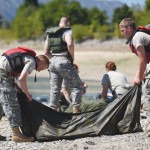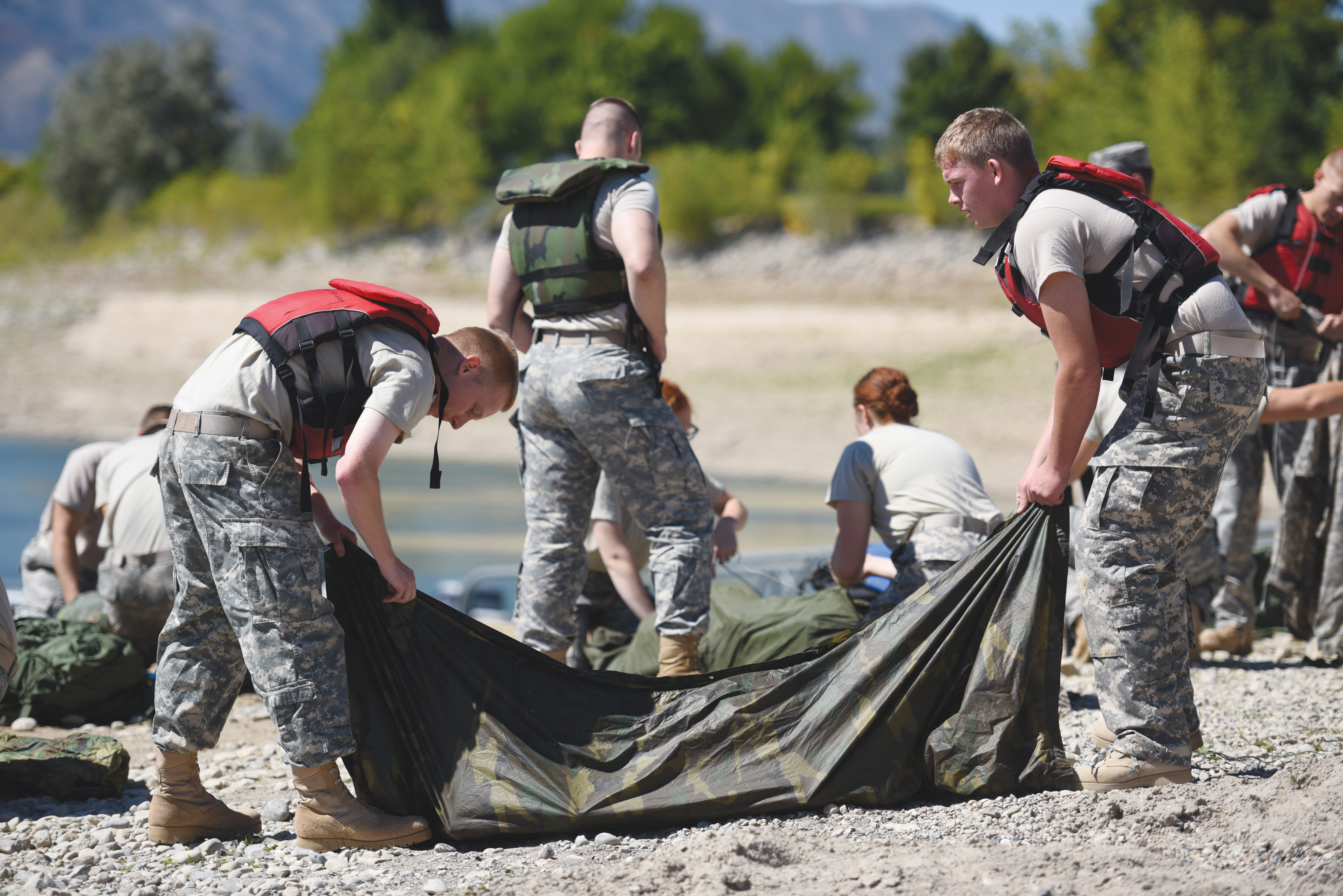ROTC students balance training, school and personal lives

ROTC members participate in a leadership training lab at Hyrum Dam on Thursday. The lab required students to make ponchos into weapon flotation devices and maneuver zodiac boats across the dam. Photo credit: Kylee Larsen
It’s not every day that members of the Reserve Officers’ Training Corps maneuver zodiac boats across the Hyrum Dam and create weapon flotation devices out of ponchos as part of their leadership training, but on Thursday, the ROTC at Utah State University did just that.
“We are just doing an introduction to zodiacs, they’re like awesome life rafts,” said Robert Carpenter, a junor in biological engineering. “So it’s, ‘this is how you row a zodiac, this is how you sit in it,’ and we paddle out into Hyrum and do a capsize drill. If your boat gets tipped over, you have to do a count-off drill then flip the boat back over and climb back in. Then we have a little fun with it and do some boat races and we teach them how to create a floatation device out of ponchos where you could put your weapon, like your M16, inside your poncho, tie it up and let it float.”
Labs like the one at Hyrum Dam provide hands-on leadership skills that are part of the four year, non-degree ROTC program at USU. In addition, ROTC members take other leadership classes and participate in physical training classes every Monday, Wednesday and Friday at 6 a.m.
“We wake up at 5:30 a.m. and get up to campus to do P.T.,” said Bryce Bigham, junior in mechanical and aerospace engineering. “That was my first introduction to the ROTC. Everybody is lined up and in formations. Personally, I thought it was goofy. I had never seen anything like it before, but as I got a little more accustomed to it, I realized the beauty and the structure and the organization and how it functions very well.”
For Cadet Commander and biochemistry senior Cole Finan, physical training was initially the most difficult part of ROTC.
“It’s three days a week, but if you do ranger challenge it’s five days a week,” Finan said. “Right now we are in the process of building people so there’s a lot of people struggling right now but by the end of the end of the semester, they will be doing pretty good.”
Besides classes and labs, the ROTC also provides extracurricular opportunities for students who perform well in physical fitness training, academics and field training. Sam VonNiederhausern, a junior in electrical engineering, spent last summer in Alabama as a hand-to-hand combative instructor.
“It gives you so many opportunities,” VonNiederhausern said. “Because it is so dynamic, you get to do so many different things, opportunities in many different places. This summer for Air Force I got to go up to Alabama, to be a combative instructor. I mean, that’s not an everyday thing. Opportunities like that you don’t really find in other clubs or organizations on campus.”
The ROTC also helps with the Student Nutrition Access Center program on campus. Every Wednesday and Friday mornings, ROTC members pick up leftover food from restaurants on campus to donate to SNAC, which helps up to 70 students a month.
“When we first started, we were kind of skeptical of if it was really helping,” Finan said. “Then we found out it was helping so many people so we decided to keep doing it.”
A four-year commitment to waking up at 5:30 a.m. every Monday, Wednesday and Friday is not necessary to join the ROTC. Members don’t have to sign scholarships or contracts until the end of their sophomore year.
“I found out there’s up to a two-year, non-committal, come-and-try-it-out program and that was appealing to me,” Bigham said. “My mom wasn’t super pro-ROTC or military. When I told her that I wanted to join, she was kind of scared but I told her, ‘Hey, it’s two years, non-committal and if I find out at the end of two years it’s not for me, I can just walk away.’”
Members can also enter in their second year of the program if they have had prior military duty.
“I enlisted in the Air Force in 2007 and I did active duty for three years in the Air Force,” said Joshua Ceruzan, a senior in Asian studies. “Active duty is 24/7 — your job. The ROTC [focus] is you are a student first. So the difference is active duty — that’s your full-time job. ROTC is just your part-time job. You are just training to get into active duty.”
Yet balancing ROTC, school, family and social activities can be a struggle at times, Carpenter said.
“For me, personally, it’s the demand of the ROTC, biological engineering, and a wife and two kids,” Carpenter said. “The ROTC, as you get further along in the program, needs more attention and time. Which is hard to do because your degree and your family always need time. Luckily they teach you how to be a planner and that helps a little.”
Upon graduation from USU, members of the ROTC will become officers in either the U.S. Air Force or Army. From there, ROTC members can request their position. However, Finan said the purpose of the ROTC is always developement of leadership skills.
“Right now I guess it’s more development as an officer,” Finan said. “A lot of people say they want to go active or they want to go National Guard or reserve, but we have been pushing lately that it is more important to be a good officer than it is to get into the branch that they want, just continue development.”
With students training together in the ROTC and taking the same classes at USU, VonNiederhausern said members develop a family-like bond.
“It’s kind of like a family, almost,” VonNiederhausern said. “In the ROTC, since you have to work, it’s kind of like a family group that you get really close with the people … I like the human, or interpersonal, relationships that you develop there. Getting to know people and how they think differently and how they solve problems, that’s something that I really like.”
—katherine.l.larsen@gmail.com


This paragraph is truly a pleasant one it assists new internet
users, who are wishing for blogging.